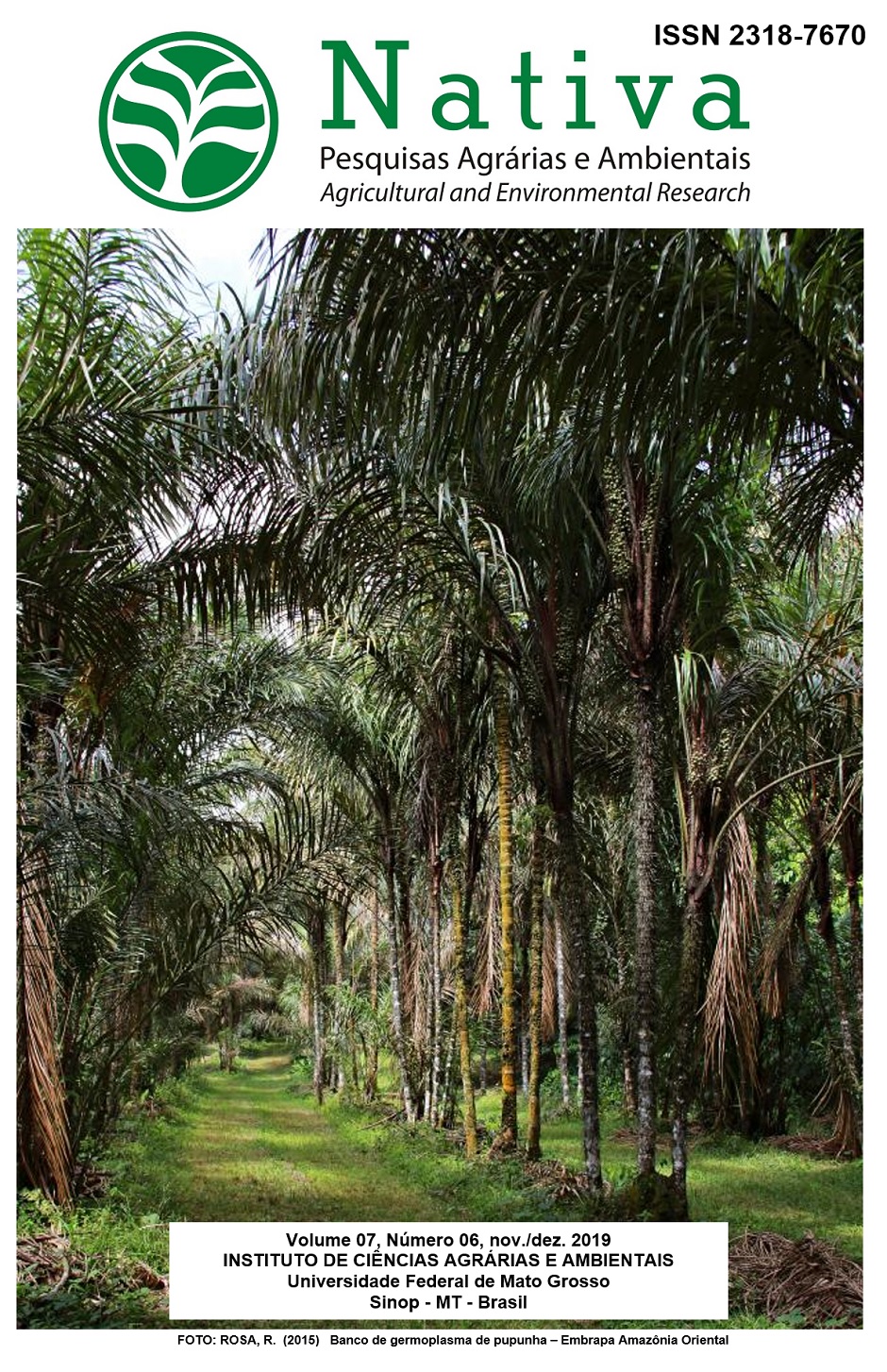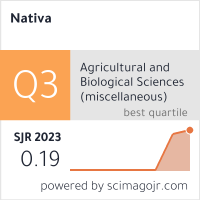DISTRIBUIÇÃO ESPACIAL E ESTRUTURA POPULACIONAL DE Parkia platycephala Benth
DOI:
https://doi.org/10.31413/nativa.v7i6.7556Resumo
O objetivo conhecer o padrão espacial e a estrutura de duas populações de Parkia platycephala, em duas áreas no sul do Piauí. Realizou-se um censo de indivíduos que apresentaram pelo menos um fuste com diâmetro altura do peito (DAP) ≥ 5 cm. Para tanto, as duas áreas amostradas foram divididas em faixas contendo 20 metros de largura. Dentro destas faixas, foram coletadas as coordenadas cartesianas o diâmetro dos indivíduos. Para o cálculo da distribuição espacial, foi aplicado a função K de Ripley univariada. Para a distribuição diamétrica foi utilizada intervalos de classes com amplitudes crescentes. Na área I foram amostrados 101 indivíduos e área basal de 7,744 m2/ha, para a área II, 66 indivíduos e área basal de 4,654 m2/ha. Os indivíduos da P. platycephala apresentou padrão de ocorrência agregado em ambas as áreas. Os indivíduos menores ocorrem próximos dos indivíduos maiores, formando população agregada. Em relação ao padrão espacial dos indivíduos por classe diamétrica predominou-se o aleatório, diferindo em intensidades, à medida que aumenta os diâmetros. As classes de diâmetro e altura revelam possíveis dificuldades de recrutamento, isso porque a maioria dos indivíduos estão acima de 10cm de diâmetro e 6m de altura respectivamente.
Palavras-chave: função K de Ripley; análise espacial; conservação.
SPATIAL DISTRIBUTION AND POPULATION STRUCTURE OF Parkia platycephala Benth
ABSTRACT:
The objective was to know the spatial pattern and structure of two populations of Parkia platycephala, in two areas in the south of Piauí. A census was taken of individuals who had at least one bole with breast height diameter (DBH) ≥ 5 cm. To do so, the two areas sampled were divided into tracks containing 20 meters wide. Within these ranges, the Cartesian coordinates were the diameter of the individuals. To calculate the spatial distribution, the univariate Ripley K function was applied. For the diametrical distribution, class intervals with increasing amplitudes were used. In area I, 101 individuals and basal area of 7,744 m2 / ha were sampled, for area II, 66 individuals and basal area of 4,654 m2 / ha. The individuals of P. platycephala showed an aggregate occurrence pattern in both areas. Smaller individuals occur close to larger individuals, forming an aggregate population. In relation to the spatial pattern of the individuals by diametric class the random was predominant, differing in intensities, as the diameters increase. The diameter and height classes reveal possible recruitment difficulties, which is why most individuals are above 10cm in diameter and 6m in height, respectively.
Keywords: Ripley's K function; spatial analysis; conservation.
Referências
ALVARES, C. A.; STAPE, J. L.; SENTELHAS, P. C.; GONÇALVES, J. L. de M.; SPAROVEK, G. Köppen’s climate classification map for Brazil. Meteorologische Zeitschrift, Berlin, v. 22, n. 6, p. 711-728, 2013. https://dx.doi.org/10.1127/0941-2948/2013/0507
ALVES, A. A.; SALES, R. O.; NEIVA, J. N.; MEDEIROS, A. N.; BRAGA, A. P.; AZEVEDO, A. R. Degradabilidade ruminal in situ de vagens de faveira (Parkia platycephala Benth.) em diferentes tamanhos de partículas. Revista Brasileira de Medicina Veterinária e Zootecnia, Belo Horizonte, v. 59, n. 4, p. 1045-1051, 2007. DOI: http://dx.doi.org/10.1590/S0102-09352007000400034
ALVES, L. R.; OLIVEIRA, R. J.; COIMBRA, R. R.; FERREIRA, W. M. Crescimento inicial de Parkia platycephala (Benth.) e Enterolobium timbouva (Mart.) sob condições de campo numa área de Cerrado. Revista Ceres, Viçosa, v. 63, n. 2, p. 154-164, 2016. https://dx.doi.org/10.1590/0034-737X201663020006
APPOLINÁRIO, V.; OLIVEIRA–FILHO, A. T.; GUILHERME, F. A. G. Tree population and community dynamics in a Brazilian tropical semideciduous forest. Revista Brasileira de Botânica, São Paulo, v. 28, n. 2, p. 347-360, 2005. DOI: http://dx.doi.org/10.1590/S0100-84042005000200014
ARAÚJO, E. J. G.; DAVID, H. C.; NETTO, S. P.; MORAIS, V. A.; SCOLFORO, J. R. S. Padrão espacial de espécies arbóreas em fragmento de floresta estacional semidecidual. Revista de Ciências Agrárias, Belém, v. 57, n. 2, p. 166-171, 2014. DOI: http://dx.doi.org/10.4322/rca.2014.010
ARRUDA, L.; DANIEL, O. Florística e diversidade em um fragmento de floresta estacional semidecidual aluvial em Dourados-MS. Floresta, Curitiba, v. 37, n. 2, p. 189-199, 2007. DOI: http://dx.doi.org/10.5380/rf.v37i2
BARBOSA, A. S.; ANDRADE, A. P.; PEREIRA JÚNIOR, L. R.; BRUNO, R. L. A.; MEDEIROS, R. L. S.; BARBOSA NETO, M. A. Estrutura populacional e espacial de Cereus jamacaru DC. Em duas áreas de caatinga do agreste da Paraíba, Brasil. Ciência Florestal, Santa Maria, v. 27, n. 1, p. 315-324, 2017. http://dx.doi.org/10.5902/1980509826469
BRUZINGA, J. S.; OLIVEIRA, M. L. R.; MACHADO, E. L. M.; LEITE, H. G.; PEREIRA, I. M.; NOGUEIRA, G. S. Distribuição espacial de indivíduos adultos de pequi. Scientia Forestalis, Piracicaba, v. 41, n. 98, p. 249-256, 2013.
BULHÃO, C. F.; PAULO S. FIGUEIREDO, P. S. Fenologia de leguminosas arbóreas em uma área de cerrado marginal no nordeste do Maranhão. Revista Brasileira de Botânica, São Paulo, v. 25, n. 3, p. 361-369, 2002. DOI: http://dx.doi.org/10.1590/S0100-84042002000300012
CAPRETZ, R. L.; BATISTA, J. L. F.; SOTOMAYOR, J. F. M.; CUNHA, C. R.; NICOLETTI, M. F.; RODRIGUES, R. R. Padrão espacial de quatro formações florestais do estado de São Paulo, através da função K de Ripley. Ciência Florestal, Santa Maria, v. 22, n. 3, p. 551-565, 2012. DOI: http://dx.doi.org/10.5902/198050986622
CONDIT, R.; ASHTON, P. S.; BAKER, P.; BUNYAVEJCHEWIN, S.; GUNATILLEKE, S.; GUNATILLEKE, N.; HUBBELL, S. P.; FOSTER, R. B.; ITOH, A.; LAFRANKIE, J. V.; LEE, H. S.; LOSOS, E.; MANOKARAN, N.; SUKUMAR, R.; YAMAKURA, T. Spatial Patterns in the Distribution of Tropical Tree Species. Science, v. 288, n. 5470, p. 1414–1418, 2000. DOI: https://dx.doi.org/10.1126/science.288.5470.1414
DALMASO, C. A.; INOUE, M. T.; OLIVEIRA, P. C. F. O.; MARCELINO, V. R.; POTTKER, G. S. Análise dos padrões espaciais de Ocotea odorifera (Vell.) Rohwer na Floresta Nacional de Irati (PR). Revista Ambiência, Guarapuava, v. 8, n. 4, p. 559-570, 2012. DOI: http://dx.doi.org/10.5777/ambiencia.2012.04.10
DORNELES, L. P. P.; NEGRELLE, R. R. B. Aspectos da regeneração natural de espécies arbóreas da Floresta Atlântica. Heringia, v.53, n.1, p.585-100, 2000.
FORZZA, R. C.; BAUMGRATZ, J. F. A.; BICUDO, C. E. M.; CARVALHO JR, A. A.; COSTA, A.; COSTA, D. P. Catálogo de plantas e fungos do Brasil. Rio de Janeiro: Andrea Jakobsson Estúdio - Instituto de Pesquisa Jardim Botânico do Rio de Janeiro, 2010. 1 v. 871 p.
IBDF_INSTITUTO BRASILEIRO DE DESENVOLVIMENTO FLORESTAL - IBDF. Padronização da nomenclatura comercial brasileira das madeiras tropicais amazônicas. Brasília, 1987. 85 p.
KUHLMANN, M.; RIBEIRO, J. F.; SANTOS, D. S.; SAMPAIO, A. Época de coleta de frutos e sementes nativos para recomposição ambiental no bioma Cerrado. Documentos Embrapa Cerrados, 2018. 40 p.
LORENZI, H. Árvores brasileiras: manual de identificação e cultivo de plantas arbóreas nativas do Brasil. São Paulo: Instituto Plantarum, 2002. 368 p.
MACHADO, S. A.; SANTOS, A. A. P.; ZAMIN, N. T.; NASCIMENTO, R. G. M. Distribuição espacial de um fragmento de Floresta Ombrófila Mista Montana. Ciência Rural, Santa Maria, v. 42, n. 6, p. 1013-1019, 2012. http://dx.doi.org/10.1590/S0103-84782012005000029
MEIRA JUNIOR, M. S.; MOTA, S. L. L.; MACHADO, E. L. M.; PEREIRA, I. M. Distribuição espacial de Eremanthus incanus (Less.) Less. (Asteraceae) em duas áreas com diferentes níveis de conservação. R. bras. Bioci., Porto Alegre, v. 15, n. 1, p. 27-31, 2017.
NASCIMENTO, I. L.; ALVES, E. U.; BRUNO, R. L. A.; GONÇALVES, E. P.; COLARES, P. N. Q.; MEDEIROS, M. S. Superação da dormência em sementes de faveira (Parkia platycephala Benth.). Revista Árvore, Viçosa, v. 33, n. 1, p. 35-45, 2009.
NEGRINI, M.; AGUIAR, M. D.; VIEIRA, C. T.; SILVA, A. C.; HIGUCHI, P. Dispersão, distribuição espacial e estratificação vertical da comunidade arbórea em um fragmento florestal no Planalto Catarinense. Revista Árvore, Viçosa, v. 36, n. 5, p. 919-930, 2012. http://dx.doi.org/10.1590/S0100-67622012000500014
ODUM, E. P. Ecologia. Rio de Janeiro: Guanabara Koogan, 2010. 434 p.
ODUM, E. P. Ecologia. Rio de Janeiro: Guanabara Koogan, 1988. 434 p.
QIN, H.; DONG, G.; ZHANG, Y.; ZHANG, F.; WANG, M. Patterns of species and phylogenetic diversity of Pinus tabuliformis forests in the eastern Loess Plateau, China. Forest Ecology and Management, Amsterdam, v. 394, p. 42–51, 15 jun. 2017. DOI: https://dx.doi.org/10.1016/j.foreco.2017.03.030
PEREIRA, A. A.; NETTO, S. P.; CARVALHO, L. M. T. Análise da distribuição espacial de jequitibarosa em uma Floresta Estacional Submontana. Revista Acadêmica, Curitiba, v. 4, n. 2, p. 21-34, 2006. DOI: http://dx.doi.org/10.7213/cienciaanimal.v4i2.9321
RIPLEY, B. D. Tests of randomness for spatial point patterns. Journal of the Royal Statistic Society, v. 41, n. 3, p. 368-374, 1979. DOI: https://dx.doi.org/10.1111/j.2517-6161.1979.tb01091.x
RIPLEY, B. D. Modelling spatial patterns. Journal of the Royal Statistic Society, London, v. 39, n. 2. p. 172-212, 1977. DOI: https://dx.doi.org/10.1111/j.2517-6161.1977.tb01615.x
ROWLINGSON, B.; DIGGLE, P. Splancs: Spatial and space-time point pattern analysis. R package version 2.01-40. Disponível em: <https://CRAN.R-project.org/package=splancs>. Acesso em: 10 Nov. 2018.
SANTANA, J. G.; NAVES, R. V. Caracterização de ambientes de cerrado com alta densidade de pequizeiros (Caryocar brasiliense Camb.) na região sudeste do estado de Goiás. Pesquisa Agropecuária Tropical, Goiânia, v. 33, n. 1, p. 1-10, 2003.
SANTOS, C. E. M.; MORGADO, M. A. D.; MATIAS, R. G. P.; WAGNER JÚNIOR, A.; BRUCKNER, C. H. Germination and emergence of passion fruit (Passiflora edulis) seeds obtained by self-and open-pollination. Acta Scientiarum. Agronomy, Maringá, v. 37, n. 4, p. 489-493, 2015. DOI: http://dx.doi.org/10.4025/actasciagron.v37i4.19616
SANTOS, H. G. dos; CARVALHO JUNIOR, W. de; DART, R. de O.; AGLIO, M. L. D.; SOUSA, J. S. de; PARES, J. G.; FONTANA, A.; MARTINS, A. L. da S.; OLIVEIRA, A. P. de. O novo mapa de solos do Brasil: Legenda atualizada. Rio de Janeiro: Embrapa Solos, 2011. 67 p. (Embrapa Solos. Documentos, 130).
SILVA, M. A. da; MELLO, M. J. de; SCOLFORO, J. R. S.; JÚNIOR, L. C.; ANDRADE, I. S.; OLIVEIRA, A. D. Análise da distribuição espacial da candeia (análise da distribuição espacial da candeia (Eremanthus erythropappus (dc.) Macleish) sujeita ao sistema de manejo porta-sementes. Cerne, Lavrasv. 14, n. 4, p. 311-316, 2008.
SONG, H.; XU, Y.; HAO, J.; ZHAO, B.; GUO, D.; SHAO, H. Investigating distribution pattern of species in a warm temperate conifer-broadleaved-mixed forest in China for sustainably utilizing forest and soils. Science of The Total Environment, Amsterdam, v. 578, p. 81-89, 2017. DOI: https://dx.doi.org/10.1016/j.scitotenv.2016.07.218
STOYAN, D.; PENTTINEN, A. Recent applications of point process methods in forestry statistics. Statistical Science, Hayward, v. 15, n. 1, p. 61–78, 2000.
TOWNSEND, C. R.; BEGON, M.; HARPER, J. L. Fundamentos em ecologia. 3.ed. Porto Alegre: Artmed, 2010. 576 p.
VIEIRA, D. S.; OLIVEIRA, M. L. R.; GAMA, J. R. V. MACHADO, E. L. M. GӦRGENS, R. B.; LAFETÁ, B. O.; GARCIA J. S. Phytosociology of a natural fragment of the floodplain forest in the Lower Tapajós River, Brazil. Bosque, Valdivia, v. 38, n. 2, p. 357-369, 2017. DOI: http://dx.doi.org/10.4067/S0717-92002017000200013
Downloads
Publicado
Edição
Seção
Como Citar
Licença
Direitos Autorais para artigos publicados nesta revista são do autor, com direitos de primeira publicação para a revista. Em virtude de a aparecerem nesta revista de acesso público, os artigos são de uso gratuito, com atribuições próprias, em aplicações educacionais e não-comerciais.
A artigos publicados nessa revista, podem ser reproduzidos parcialmente ou utilizados como referência por outros autores, desde que seja cita a fonte, ou seja, a Revista Nativa.
Copyright for articles published in this journal are the authors, with first publication rights granted to the journal. The journal shows open access, and articles are free to use, with proper attribution, in educational and non-commercial.
The articles published in this journal may be reproduced in part or used as a reference by other authors, provided that the source is quoted.






